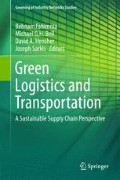Abstract
It is well known that a significant amount to passenger trip activity involves multiple modes, destinations and trip purposes. For example, with multi-worker households, we observe a car commuter taking a child to a child care centre en route to work and also dropping their partner off at another location such as a railway station. This example is one of many trip chain configurations that represent the complexity of travel activity, and which have important implications on how we represent travel demand in transport planning models. What is not well understood is the impact that trip chaining has on greening the demand chain. We are unaware of any studies that have investigated the greening of passenger demand chains associated with the complexity of trip chains. This chapter uses the Sydney Household Travel Survey and an econometric model to identify the impact that the changing nature of trip chains has on CO2 emission. Results suggest that trip chains were stable in Sydney over a period of 15-year from 1997/98 to 2011/12. Emissions saving from chaining multiple activities into a single chain were found to vary between 5 and 19 % depending on whether the mode of travel is car, bus, or train.
Access this chapter
Tax calculation will be finalised at checkout
Purchases are for personal use only
References
Adler, T., & Ben-Akiva, M. (1979). A theoretical and empirical model of trip chaining behavior. Transportation Research Part B: Methodological, 13, 243–257.
Bradley, M., & Bowman, J. (2006). SACSIM/05 activity-based travel forecasting model for SACOG: Featuring DAYSIM—the person day activity and travel simulator. Technical memo number 4: Mode choice models. Prepared for Sacramento Area Council of Governments (SACOG).
Cicillo, C., & Axhausen, K. (2002) Mode choice of complex tours. Association for European Transport (pp. 9–11). Cambridge, England.
Currie, G., & Delbosc, A. (2011). Exploring the trip chaining behaviour of public transport users in Melbourne. Transport Policy, 18, 204–210.
Davidson, W., Donnelly, R., Vovsha, P., Freedman, J., Ruegg, S., Hicks, J., et al. (2007). Synthesis of first practices and operational research approaches in activity-based travel demand modeling. Transportation Research Part A: Policy and Practice, 41, 464–488.
Demographia. (2007). Greenhouse gas emission per passenger km: Australia. Available: www.demographia.com/db-australghg.pdf.
Golob, T. F. (1986). A nonlinear canonical correlation analysis of weekly trip chaining behaviour. Transportation Research Part A: General, 20, 385–399.
Hensher, D. A., & Reyes, A. J. (2000). Trip chaining as a barrier to the propensity to use public transport. Transportation, 27, 341–361.
Ho, C., & Mulley, C. (2013a). Multiple purposes at single destination: A key to a better understanding of the relationship between tour complexity and mode choice. Transportation Research Part A: Policy and Practice, 49, 206–219.
Ho, C., & Mulley, C. (2013b). Tour-based mode choice of joint household travel patterns on weekend and weekdays. Transportation, 40, 789–811.
Krizek, K. J. (2003). Neighborhood services, trip purpose, and tour-based travel. Transportation, 30, 387–410.
Krygsman, S., Arentze, T., & Timmermans, H. (2007). Capturing tour mode and activity choice interdependencies: A co-evolutionary logit modelling approach. Transportation Research Part A: Policy and Practice, 41, 913–933.
Levinson, D., & Kumar, A. (1995). Activity, travel, and the allocation of time. Journal of the American Planning Association, 61, 458–470.
McGuckin, N., Zmud, J., & Nakamoto, Y. (2005). Trip-chaining trends in the United States: Understanding travel behavior for policy making. Transportation Research Record: Journal of the Transportation Research Board, 1917, 199–204.
Primerano, F., Taylor, M., Pitaksringkarn, L., & Tisato, P. (2008). Defining and understanding trip chaining behaviour. Transportation, 35, 55–72.
Strathman, J. G., Dueker, K. J., & Davis, J. S. (1994). Effects of household structure and selected travel characteristics on trip chaining. Transportation, 21, 23–45.
Ye, X., Pendyala, R. M., & Gottardi, G. (2007). An exploration of the relationship between mode choice and complexity of trip chaining patterns. Transportation Research Part B: Methodological, 41, 96–113.
Author information
Authors and Affiliations
Corresponding author
Editor information
Editors and Affiliations
Rights and permissions
Copyright information
© 2015 Springer International Publishing Switzerland
About this chapter
Cite this chapter
Ho, C., Hensher, D.A. (2015). Greening Demand Chains in Urban Passenger Transport: Emissions Saving from Complex Trip Chains. In: Fahimnia, B., Bell, M., Hensher, D., Sarkis, J. (eds) Green Logistics and Transportation. Greening of Industry Networks Studies, vol 4. Springer, Cham. https://doi.org/10.1007/978-3-319-17181-4_8
Download citation
DOI: https://doi.org/10.1007/978-3-319-17181-4_8
Published:
Publisher Name: Springer, Cham
Print ISBN: 978-3-319-17180-7
Online ISBN: 978-3-319-17181-4
eBook Packages: Earth and Environmental ScienceEarth and Environmental Science (R0)

